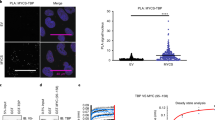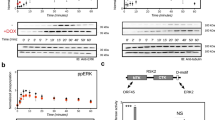Abstract
A STRUCTURAL motif for DNA-binding proteins, the "leucine zipper", has been proposed for the jun,fos and myc gene products, the yeast transcriptional activator GCN4, and the C/EBP enhancer-binding protein1. These proteins all contain a region with four or five leucine residues spaced exactly seven amino acid residues apart whose sequence is consistent with the formation of an amphipathic α-helix. It has been proposed that the leucine zipper consists of two interdigitated α-helices, one from each monomer, that constitute the dimerization function necessary for high-affinity binding to DNA; an adjacent region of basic residues is thought to be responsible for specific protein-DNA contacts1. In support of this model, substitution of the leucine residues within the motif can abolish dimerization and DNA-binding2–6, and a synthetic peptide corresponding to the GCN4 leucine zipper forms a-helical dimers7. Despite the conserved leucine residues, however, each protein has a distinct dimerization specificity. Specifically, GCN4 homodimer, Jun homodimer and Fos-Jun heterodimer proteins bind to the same DNA site, whereas Fos is unable to form homodimers, bind DNA, or interact with GCN4 (refs 8–14). Here, we alter the dimerization specificity of Fos by precisely replacing its leucine zipper with that from GCN4. This Fos-GCN4 chimaeric protein is able to bind to the target site in the absence of Jun, and can form DNA-binding heterodimers with GCN4 but not with Jun. These results indicate that the leucine zipper is sufficient to confer dimerization specificity and strongly suggest that Fos contacts DNA directly.
This is a preview of subscription content, access via your institution
Access options
Subscribe to this journal
Receive 51 print issues and online access
$199.00 per year
only $3.90 per issue
Buy this article
- Purchase on Springer Link
- Instant access to full article PDF
Prices may be subject to local taxes which are calculated during checkout
Similar content being viewed by others
References
Landschulz, W. H., Johnson, P. F. & McKnight, S. L. Science 240, 1759–1764 (1988).
Kóuzarides, T. & Ziff, E. Nature 336, 646–651 (1988).
Landschulz, W. H., Johnson, P. F. & McKnight, S. L. Science 243, 1681–1688 (1989).
Turner, R. & Tjian, R. Science 243, 1689–1964 (1989).
Gentz, R., Rauscher III, F. J., Abate, C. & Curran, T. Science 243, 1695–1699 (1989).
Schuermann, M. et al. Cell 56, 507–516 (1989).
O'Shea, E. K., Rutkowski, R. & Kim, P. Science 243, 538–542 (1989).
Hope, I. A. & Struhl, K. EMBO J. 6, 2781–2784 (1987).
Struhl, K. Cell 50, 841–846 (1987).
Bohmann, D. et al. Science 238, 1386–1392 (1987).
Angel, P. et al. Nature 332, 166–171 (1988).
Nakabeppu, Y., Ryder, K. & Nathans, D. Cell 55, 907–915 (1988).
Halazonetis, T. D., Georgopoulos, K., Greenberg, M. E. & Leder, P. Cell 55, 917–924 (1988).
Sassone-Corsi, P., Ransone, L. J., Lamph, W. W. & Verma, I. M. Nature 336, 692–695 (1988).
Hill, D. E., Hope, I. A., Macke, J. P. & Struhl, K. Science 234, 451–457 (1986).
Oliphant, A. R., Brandl, C. J. & Struhl, K. Molec. Cell. Biol. 9, 2944–2949 (1989).
Hope, I. A. & Struhl, K. Cell 46, 885–894 (1986).
Little, J. W. & Hill, S. A. Proc. natn. Acad. Sci. U.S.A. 82, 2301–2305 (1985).
Hurstel, S., Granger-Schnarr, M. & Schnarr, M. EMBO J. 7, 269–275 (1988).
Hope, I. A., Mahadevan, S. & Struhl, K. Nature 333, 635–640 (1988).
Lech, K., Anderson, K. & Brent, R. Cell 52, 179–184 (1988).
Kunkel, T. A., Roberts, J. D. & Zakour, R. A. Meth. Enzym. 154, 367–382 (1987).
Struhl, K. Nature 332, 649–650 (1988).
Author information
Authors and Affiliations
Rights and permissions
About this article
Cite this article
Sellers, J., Struhl, K. Changing Fos oncoprotein to a Jun-independent DNA-binding protein with GCN4 dimerization specificity by swapping "leucine zippers". Nature 341, 74–76 (1989). https://doi.org/10.1038/341074a0
Received:
Accepted:
Issue Date:
DOI: https://doi.org/10.1038/341074a0
This article is cited by
-
Identification of a novel liver-specific expressed gene, TCP10L, encoding a human leucine zipper protein with transcription inhibition activity
Journal of Human Genetics (2003)
-
A maize DNA-binding factor with a bZIP motif is induced by low temperature
Molecular and General Genetics MGG (1995)
-
Gene regulation in microbial eukaryotes in the early 1990s
World Journal of Microbiology and Biotechnology (1992)
-
Folding transition in the DMA-binding domain of GCN4 on specific binding to DNA
Nature (1990)
-
Action of leucine zippers
Nature (1989)
Comments
By submitting a comment you agree to abide by our Terms and Community Guidelines. If you find something abusive or that does not comply with our terms or guidelines please flag it as inappropriate.



